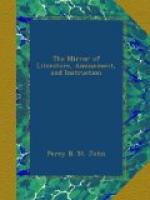American Sea-Serpent.
Mr. Samuel Mitchell has, in his “Summary of the Progress of Natural Science for the last few Years,” given an amusing account of the progress of sea-serpentism. It was read before the New York Lyceum, and is inserted in the American Journal of Science, although not thought conclusive by its learned editor, Dr. Silliman. The first sea-serpent was a steam-boat, which, being established at Boston to coast along the shore, and from its powers and capabilities competent to injure the business of small boats, was described as a sea-serpent that had been seen off Nahant and Gloucester, and had probably come there to consume all the small fish in the place. This was received by many as a serious account, and believed accordingly.
Another sea-serpent history arose from the circumstance, that a small sloop, called the Sea-Serpent, having been passed by another vessel, the captain of the latter, when asked, upon his arrival at home, for news, said he had seen a sea-serpent, and then described its bunches on the back, the action of its tail, and other parts; all of which being understood literally, actually appeared in print, as evidence for the existence of the animal.
Then a piece of the skin of the bony scaled pike was taken for part of a sea-serpent’s hide. A speckled mother duck, with a numerous brood of young ones swimming after her in a line on Lake Ontario, was described as the sea-serpent itself. And from such occurrences as these, perhaps, mingled with careless observation of the motions and appearances of porpuses, basking sharks, and balaenopterous whales, appears to have originated every thing that has been said about American sea-serpents.—Brande’s Jour.
* * * * *
THE GATHERER.
A snapper up of unconsidered trifles.




